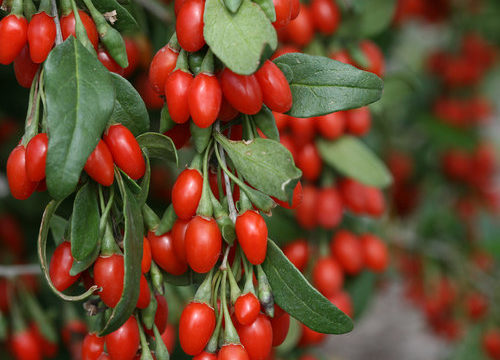Goji berries are easy to grow, so you can avoid the high price at the grocery store! Native to China, goji berries have been cultivated for centuries for their medicinal use and ornamental beauty. A woody shrub that behaves more like a determinate vine, purple flowers begin opening in late spring or early summer followed by brilliant orange-red fruits. They will bloom and fruit continuously through frost.
Proven Winners provides the following growing information:
How to grow
Zone: hardy to USDA zone 5; heat tolerant to AHS zone 9
Exposure: Full sun is best, but tolerates a bit of shade.
Height: 5-7’ (1.5-2.1 m)
Water: The plants tolerate some drought once established, but for best fruit set and quality, water regularly.
Soil: Any well-drained soil will do.
Staking: Goji naturally wants to sprawl and creep along the ground. To save space and to make harvesting the berries easier, you can bundle the strongest 3-5 canes around a 6-8’/1.8-2.4m tall stake (choose something sturdy, like 1”x1” wood).
Pests: Goji berry plants will not be bothered by insects or diseases, but birds, deer, and raccoons may all find the fruit as appealing as you do. If you notice damage to the fruit or plant, or have a problem with these visitors damaging other plants in your garden, use a netting or repellent, particularly once the plant begins flowering and fruiting.
Pruning: Goji does not require pruning to grow well and produce fruit. However, you may find the plant is more manageable and easier to harvest when its lateral (horizontal) branches are lightly pruned to encourage branching and the production of vigorous new growth.
Harvesting: Goji berries begin to ripen in early summer. They should be plucked off by hand when they are brilliant red and taste sweet. They come off the plant easily, without the need for pruners or a knife.
Fertilizing: For an abundant crop, apply a fertilizer formulated for flowering woody plants in early spring, just as new growth begins. Rose fertilizer is an excellent, readily available choice.
FAQ
Can I grow goji berry in a container?
Yes! Goji will do great in a container. Just be sure to choose one large enough – it should be at least 18” in diameter and have a drainage hole. The container should also be weatherproof so that it can remain outside, planted with your goji, all year long. Use any regular potting soil to plant in and be sure to keep a close eye on watering, particularly during the hottest part of the summer.
When are my goji berries ready to harvest?
Goji berries turn red very quickly but will taste slightly bitter until they are fully ripe. Taste is your best indicator, but in general, the berries should spend several weeks on the vine before being harvested. It is best to harvest before the first frost, however, because cold can diminish the flavor of the fruit.
Where can I grow goji berries?
Goji berries will thrive in the majority of the US and Canada. They are hardy to USDA zone 5, with maximum low temperature around -18 degrees F/-27 degrees C; if you live in a colder climate and would like to try goji, you will get berries that summer but the plant may not come back next year. Goji is very tolerant of hot and dry climates –in fact, many of its relatives grow wild in the deserts of Arizona, Texas, and Mexico.
Do I need two gojis for pollination?
No – gojis are self-fruitful. They do not require another plant to bear fruit.
How do I use my goji berries?
You can use your goji berries in the same way that you use those that you purchase in the store. They can be used fresh if you wish, or they can be frozen or dried. To dry gojis, harvest them and simply spread the fresh berries in a single layer on a sheet of newspaper. Keep in a cool, dry spot, out of bright light, until the berries are dry. They keep their color well and can be used as is or rehydrated with liquid, as your recipe and preferences dictate. To freeze, place in a freezer bag and lay flat until frozen. This keeps them from sticking together in large clumps. Well-sealed frozen goji berries should keep for several months and can be used straight from the freezer in your recipe.
